The Ministry of National Defense is keeping abreast of developments amid reports the Chinese military has deployed an advanced surface-to-air missile system to Woody Island (Yongxing Island, 永興島) in the South China Sea, spokesman Major General David Lo (羅紹和) said yesterday.
The US broadcaster Fox News on Tuesday reported that satellite images from last week appear to show two batteries of eight surface-to-air missile launchers, as well as a radar system, on Woody Island, one of the Paracel Islands (Xisha Islands, 西沙群島).
The Pentagon said the images of the buildup of missiles on the island — obtained from ImageSat International NV — were authentic.
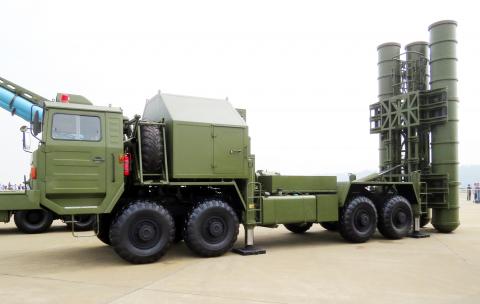
Photo: CNA
Lo said the ministry has gathered information about the HQ-9 deployment and is closely watching developments.
All parties concerned in the South China Sea dispute should work together for peace and stability in the region, and avoid any unilateral action that could accelerate tension there, he said.
China’s deployment of the missiles on or about Sunday marks a major military escalation in the region and was a clear Chinese slap in the face in response to the US-ASEAN summit held in California on Monday and Tuesday, an expert on Beijing’s military affairs told the Taipei Times.
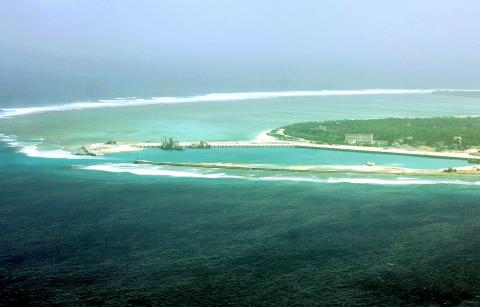
Photo: AFP
“It can now be expected that missiles will soon be deployed to Fiery Cross [Yongshu Reef, 永暑礁], Mischief [Meiji Reef, 美濟礁] and Subi reefs [Jhubi Reef, 渚碧礁],” said Richard Fisher, a senior fellow in Asian military affairs at the Alexandria, Virginia-based International Assessment and Strategy Center (IASC). “As it is only 68km away from Subi Reef, the 150 to 200 kilometer range HQ-9 anti-aircraft missile can down any aircraft approaching Taiwan’s Taiping Island [Itu Aba Island, 太平島].”
Fisher said that should such a threat to Taiping materialize, Taiwan would be justified in deploying retaliatory systems to deter China from using its missiles.
“For Washington, deterrence will now depend on the crash development of new medium-range ballistic missiles and then their deployment to the Philippines or on US Navy ships so that there is a means for immediate retaliation should China use its new island bases to attack US allies and friends,” he said.
Fox News said that it had exclusively obtained civilian satellite imagery of the missiles on Woody Island and that a US official had confirmed the accuracy of the photographs.
“The official said the imagery viewed appears to show the HQ-9 air defense system, which closely resembles Russia’s S-300 missile system,” Fox News said.
“The US continues to call on all claimants to halt land reclamation, construction and militarization of features in the South China Sea,” the official told Fox News.
The news channel also reported that a US Navy destroyer sailed close to another contested island in the Paracels a few weeks ago and that China vowed “consequences” for that action.
Woody Island is claimed by Taiwan, China and Vietnam.
The second day of Obama’s summit with ASEAN leaders at Sunnylands, California, focused on providing a united front on maritime disputes with Beijing.
The summit was already struggling with how to deal with images posted on The Diplomat magazine’s Web site showing China was continuing to expand its bases in the Paracels. Those photographs were said to show a helicopter base under construction.
In a joint statement issued on Tuesday night, summit attendees reaffirmed the key principals that would guide them in future, including mutual respect for the sovereignty, territorial integrity, equality and political independence of all nations; shared commitment to peaceful resolution of disputes without resorting to the threat or use of force; and a shared commitment to promote cooperation on challenges in the maritime domain.
The missile deployment also comes as Washington appears increasingly anxious that China might soon start flying war planes from the man-made islands it has built in the South China Sea. Such a move would increase the military threat against Taiwan and could trigger a new reaction from the US.
Vice Admiral Joseph Aucoin, commander of the US Navy’s Seventh Fleet, said earlier this week that such flights would be “destabilizing.”
Aucoin would not say when he expected the flights to start, but other sources said they could happen before June.
Briefing journalists in Singapore, Aucoin said the US would continue to “sail, fly, operate throughout these waters like we have been doing for so long.”
Last month China landed two commercial jets on Fiery Cross, one of the reefs that China has built-up in the Spratly Islands (Nansha Islands, 南沙群島).
“It demonstrates this new base has at least a rudimentary capability to support brief visits by People’s Liberation Army [PLA] fighters, bombers, radar, anti-submarine and other military aircraft,” Fisher said.
China had enough transport aircraft to carry the radar and control systems, fuel, maintenance supplies plus ordinance to enable a small number of fighter or surveillance aircraft to perform combat air patrol missions from Fiery Cross, he said
“China will use US, Australian and Japanese intention to use aircraft and ships to demonstrate freedom of navigation rights to justify a more rapid buildup of combat capabilities on its three large bases at Fiery Cross, Mischief Reef and Subi Reef,” he said.
The PLA’s S-300PMU2 surface-to-air missile system could shoot down aircraft over most of the southern part of the South China Sea from the PLA’s three new bases in the region and shoot down aircraft flying over the Philippine island of Palawan from Mischief Reef.
“China is on a roll. It simply is not going to respond to diplomatic attempts to stop its accelerating transformation of its islands into military bases, which it will eventually use to attack Taiwan, Philippine and Vietnamese islands in the South China Sea," Fisher said.
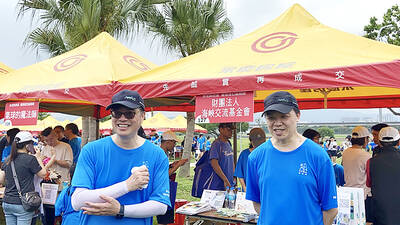
SECURITY: As China is ‘reshaping’ Hong Kong’s population, Taiwan must raise the eligibility threshold for applications from Hong Kongers, Chiu Chui-cheng said When Hong Kong and Macau citizens apply for residency in Taiwan, it would be under a new category that includes a “national security observation period,” Mainland Affairs Council (MAC) Minister Chiu Chui-cheng (邱垂正) said yesterday. President William Lai (賴清德) on March 13 announced 17 strategies to counter China’s aggression toward Taiwan, including incorporating national security considerations into the review process for residency applications from Hong Kong and Macau citizens. The situation in Hong Kong is constantly changing, Chiu said to media yesterday on the sidelines of the Taipei Technology Run hosted by the Taipei Neihu Technology Park Development Association. With

CARROT AND STICK: While unrelenting in its military threats, China attracted nearly 40,000 Taiwanese to over 400 business events last year Nearly 40,000 Taiwanese last year joined industry events in China, such as conferences and trade fairs, supported by the Chinese government, a study showed yesterday, as Beijing ramps up a charm offensive toward Taipei alongside military pressure. China has long taken a carrot-and-stick approach to Taiwan, threatening it with the prospect of military action while reaching out to those it believes are amenable to Beijing’s point of view. Taiwanese security officials are wary of what they see as Beijing’s influence campaigns to sway public opinion after Taipei and Beijing gradually resumed travel links halted by the COVID-19 pandemic, but the scale of
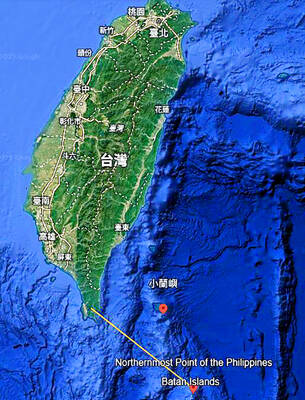
A US Marine Corps regiment equipped with Naval Strike Missiles (NSM) is set to participate in the upcoming Balikatan 25 exercise in the Luzon Strait, marking the system’s first-ever deployment in the Philippines. US and Philippine officials have separately confirmed that the Navy Marine Expeditionary Ship Interdiction System (NMESIS) — the mobile launch platform for the Naval Strike Missile — would take part in the joint exercise. The missiles are being deployed to “a strategic first island chain chokepoint” in the waters between Taiwan proper and the Philippines, US-based Naval News reported. “The Luzon Strait and Bashi Channel represent a critical access
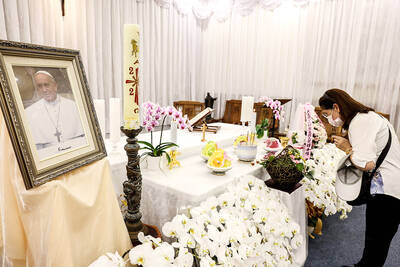
Pope Francis is be laid to rest on Saturday after lying in state for three days in St Peter’s Basilica, where the faithful are expected to flock to pay their respects to history’s first Latin American pontiff. The cardinals met yesterday in the Vatican’s synod hall to chart the next steps before a conclave begins to choose Francis’ successor, as condolences poured in from around the world. According to current norms, the conclave must begin between May 5 and 10. The cardinals set the funeral for Saturday at 10am in St Peter’s Square, to be celebrated by the dean of the College